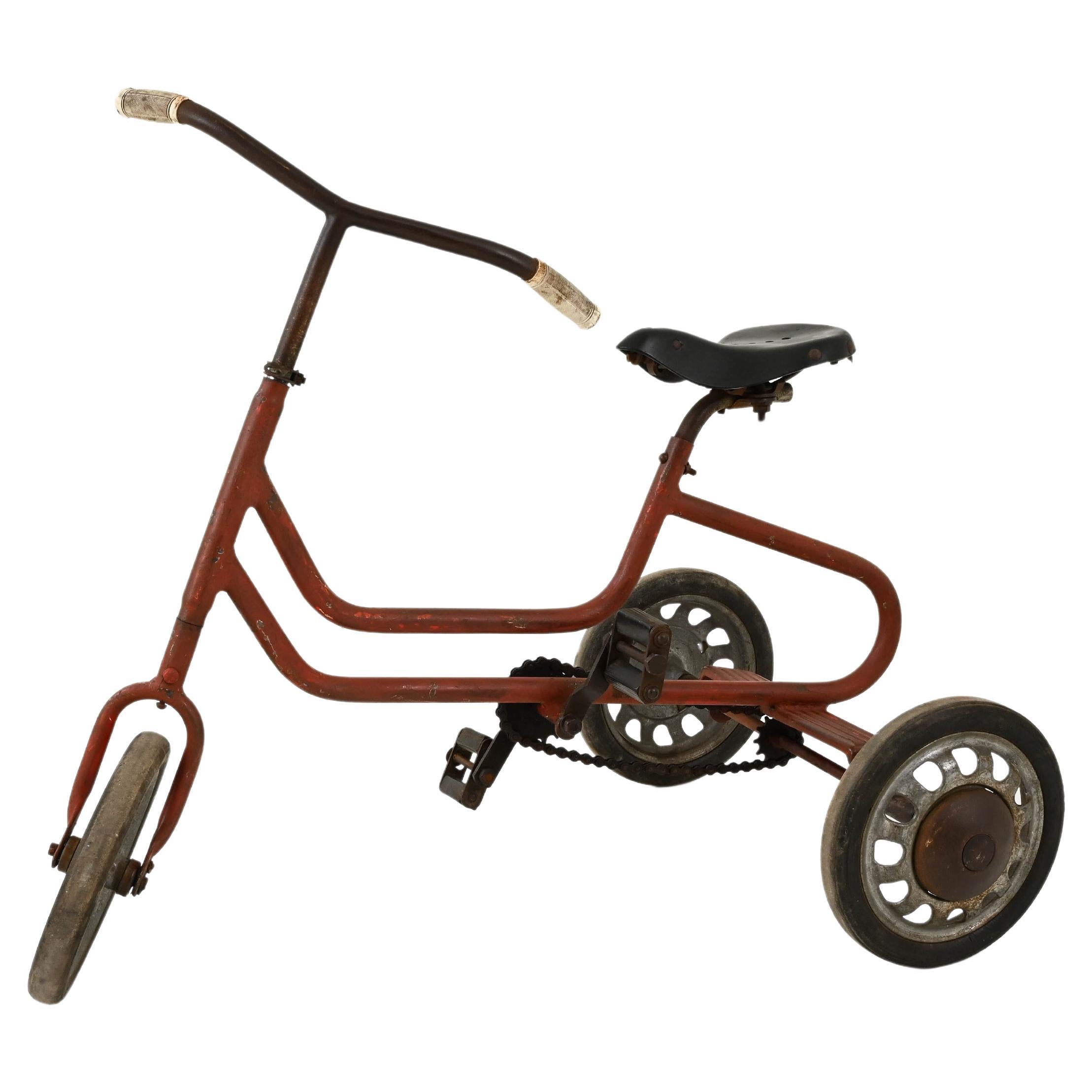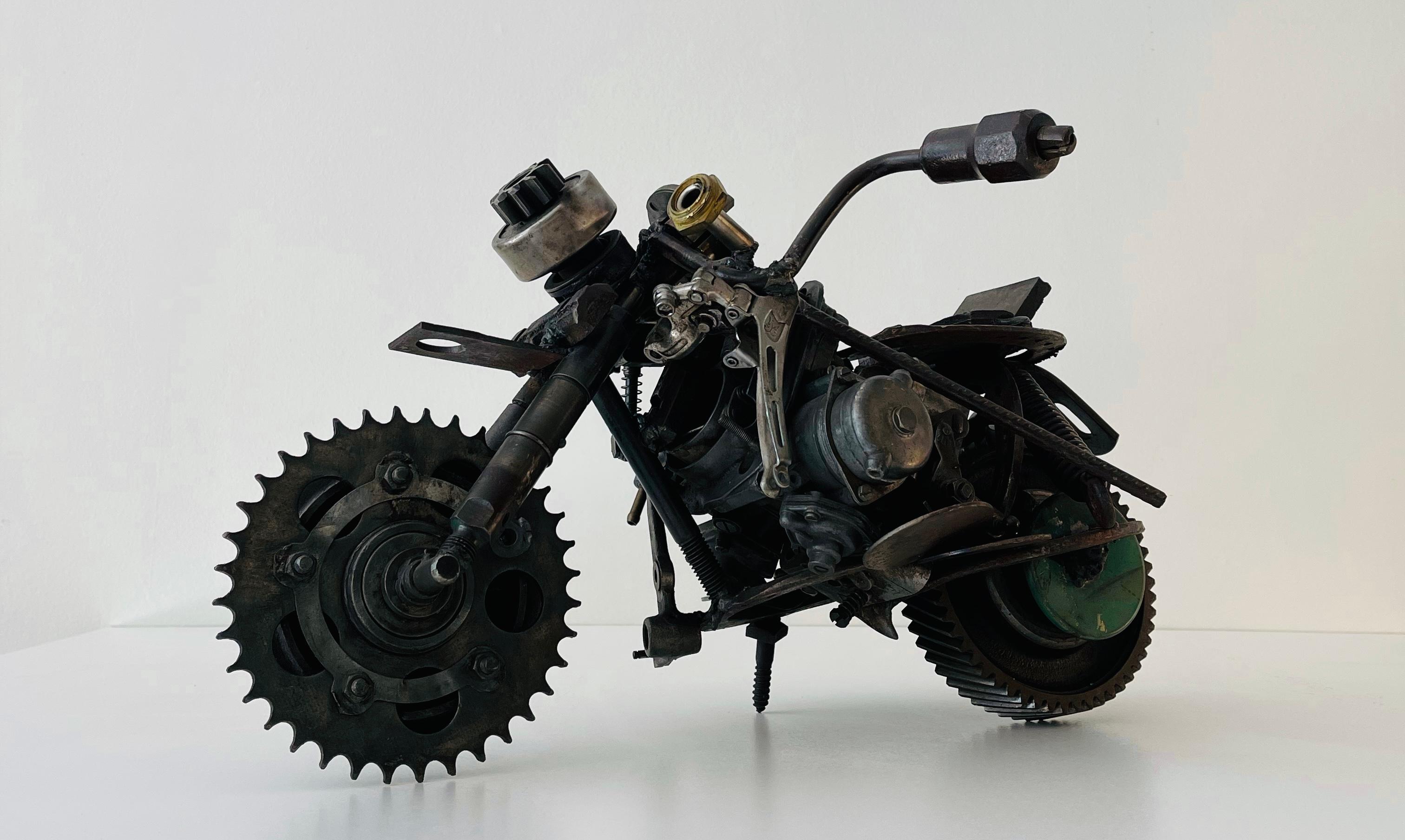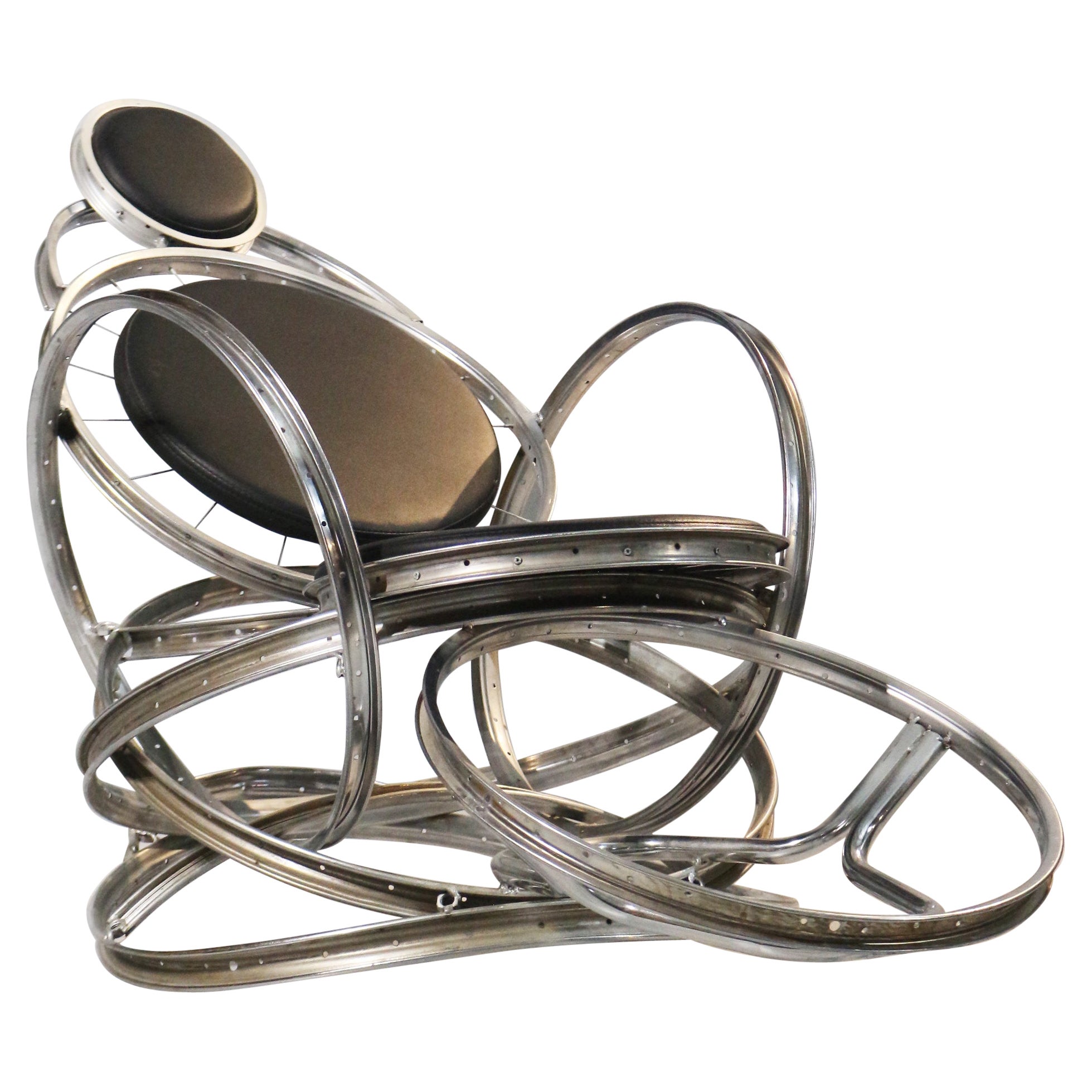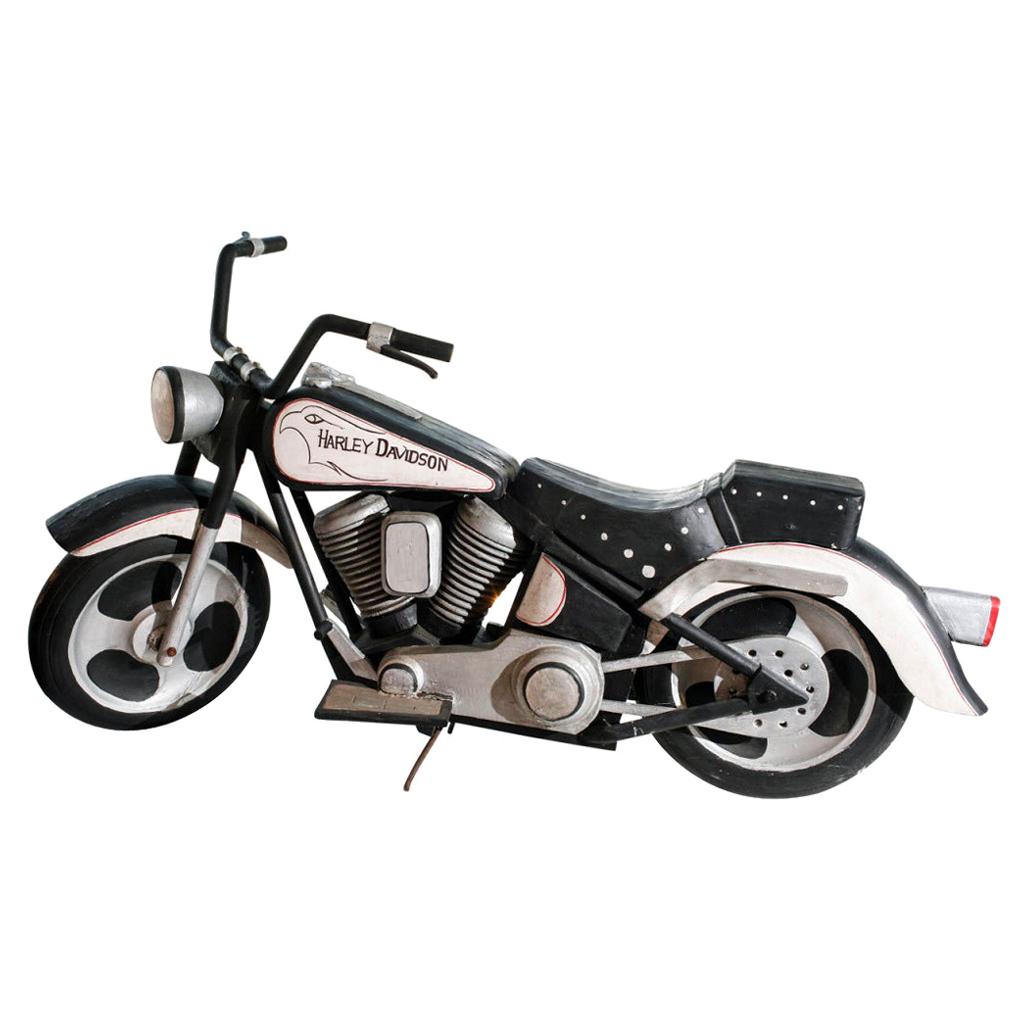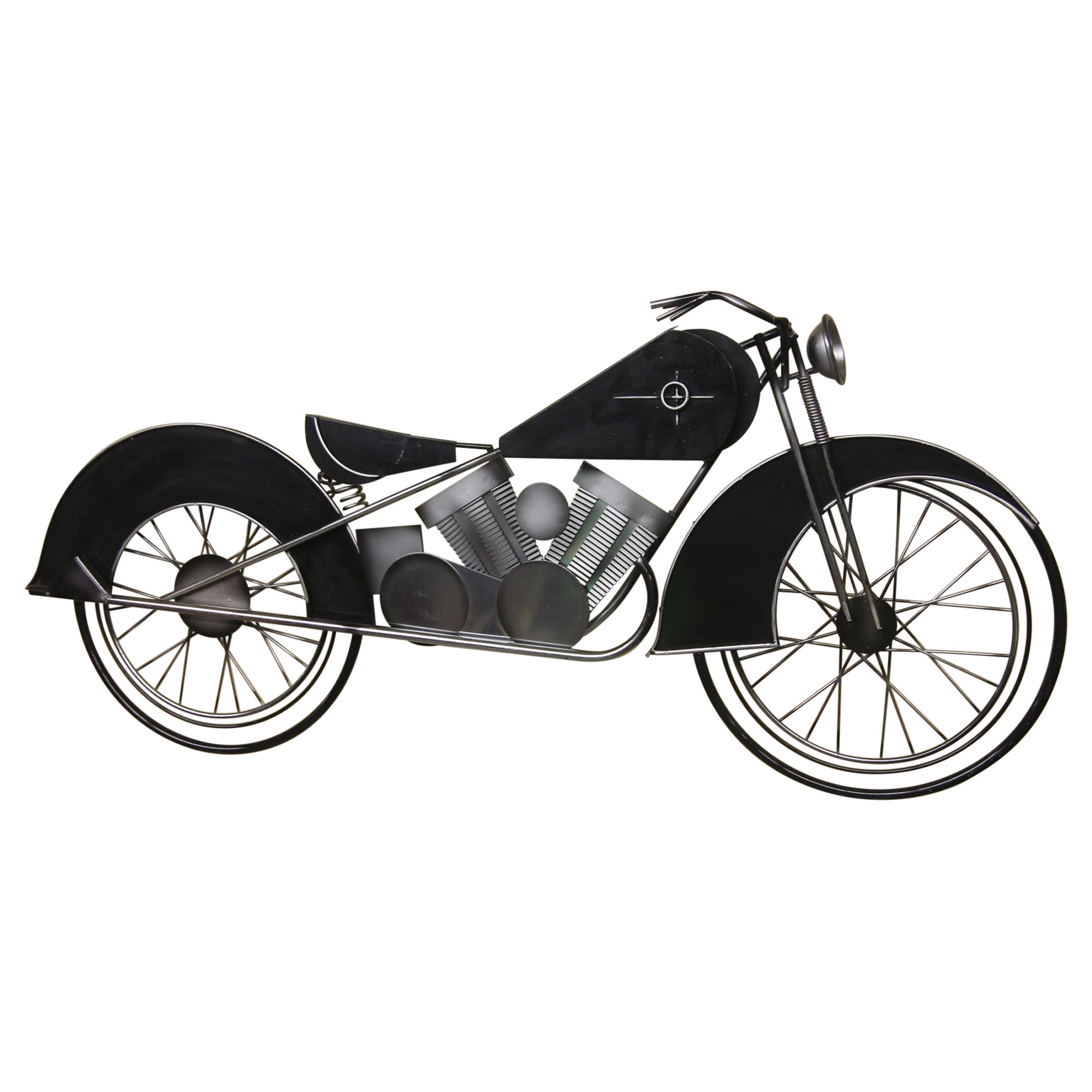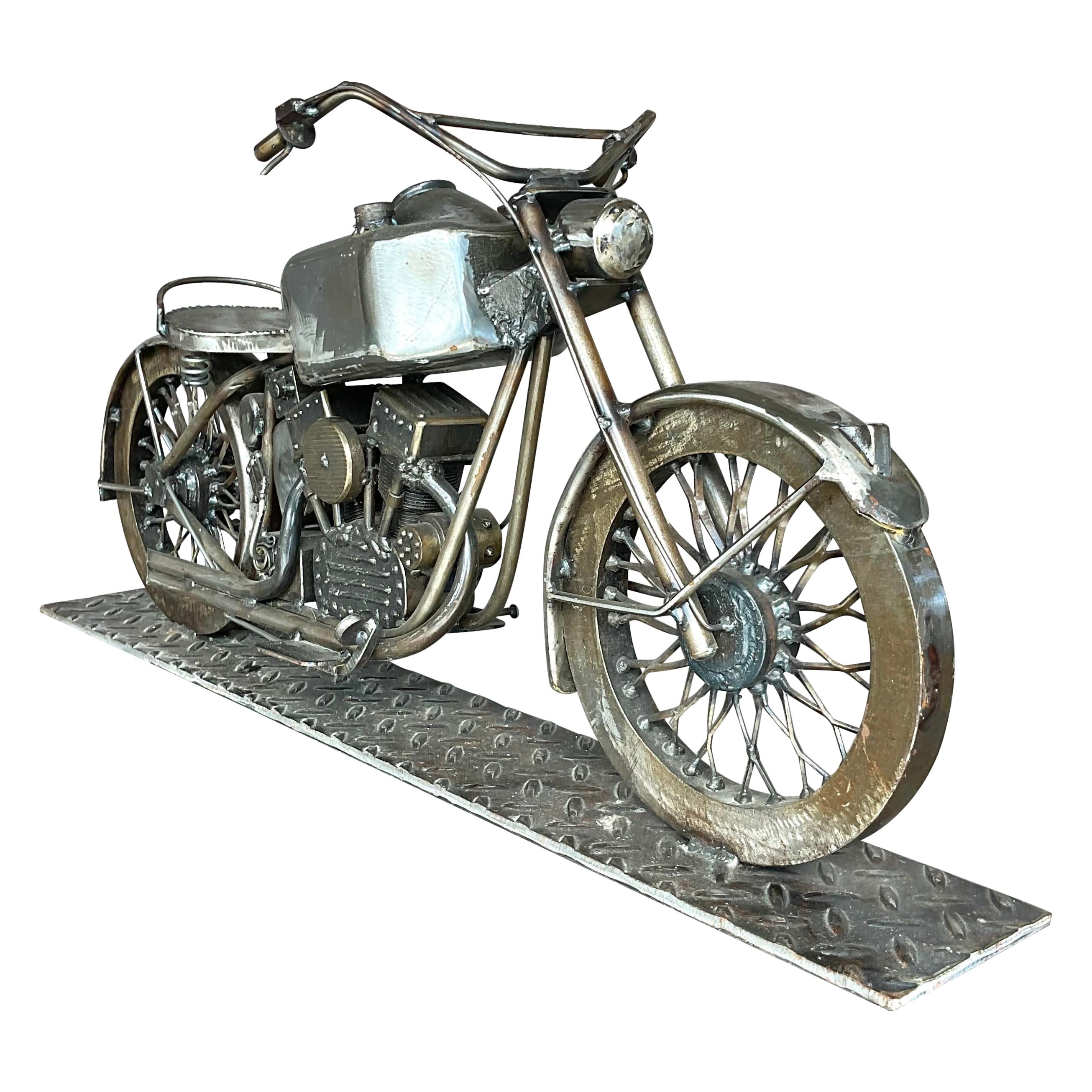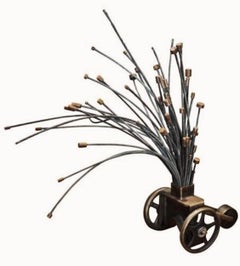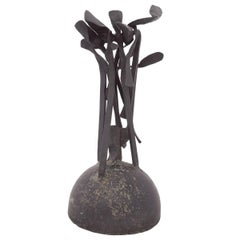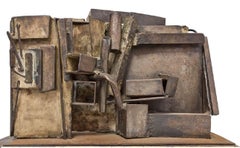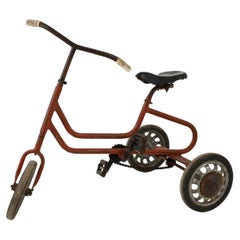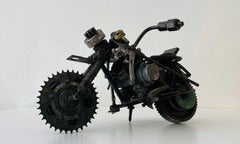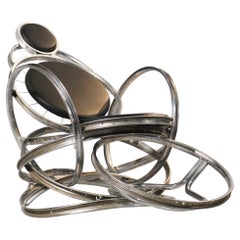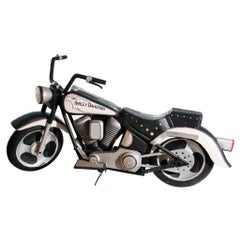Items Similar to EZ Rider Functional Sculpture Motorcycle Chair Featured in Book
Want more images or videos?
Request additional images or videos from the seller
1 of 5
Bruce GrayEZ Rider Functional Sculpture Motorcycle Chair Featured in Book
$4,000
£3,037.29
€3,473.37
CA$5,588.58
A$6,215.72
CHF 3,245.66
MX$75,638.71
NOK 41,451.98
SEK 38,874.65
DKK 25,923.12
Shipping
Retrieving quote...The 1stDibs Promise:
Authenticity Guarantee,
Money-Back Guarantee,
24-Hour Cancellation
About the Item
Genre: Contemporary Functional Sculpture
Subject: Abstract
Medium: Metal, Assemblage
Surface: Metal
Country: United States
Dimensions: 30 x 65 x 24
EZ Rider Chair is a unique functional art chair sculpture constructed from various motorcycle parts by Bruce Gray. This one is in a private collection. Variations on this theme are only limited by how much you wish to spend, such as including a custom gas tank or even a complete engine of your choice. The EZ Rider Chair is featured along with 7 other of Bruce's chairs in the book Chairs, Chairs, Chairs. (the Italian original version of the book was titled Sillas Sillas Sillas)
Bruce Gray was (born 1956 Orange, New Jersey) is an artist residing in Los Angeles. His work includes kinetic art such as rolling ball machines, mobiles, stabiles, and suspended magnetic sculptures. He also creates found objects sculptures such as a lifesize motorcycle sculpture constructed from train parts, and giant objects such as a large aluminum wedge of Swiss cheese and giant high heel shoes. Gray's work has been displayed at many museums, art galleries, and is part of over 1200 corporate and private art collections. His work has appeared in numerous films and television shows including Charmed, Austin Powers, Meet the Fockers, Batman Forever, Sleeping with the Enemy, Six Feet Under, Seinfeld, Star Trek, Friends, Frasier, Roseanne, Murphy Brown, How I Met Your Mother, and NYPD Blue.
Bruce Gray's sculptures can be seen at Little Rock National Airport, Edwards Air Force Base, Vanderbilt University, University of Pittsburgh Medical Center, Children's Hospital Boston, Kapor Enterprises, The Academy of Motion Picture Arts and Sciences, Lucile Packard Children's Hospital, Network Solutions, A&M Records, NBCUniversal, Doubletree, Embassy Suites Hotels, Southern California Edison, Kaiser Permanente, Clean Harbors, and the Rolling Ball Museum permanent collection in Seoul, South Korea.
Education
Bruce Gray attended Bridgewater Raynham Regional High School in Massachusetts and graduated in 1975.
He attended United States Coast Guard Electronics Technician and LORAN A School on Governors Island, New York and graduated in 1976.
He attended The University of Massachusetts Dartmouth from 1979 to 1983 and received a BFA in Design
- Creator:Bruce Gray (1956, American)
- Dimensions:Height: 30 in (76.2 cm)Width: 65 in (165.1 cm)Depth: 24 in (60.96 cm)
- Medium:
- Period:
- Condition:minor wear, could be original from the assembled parts.
- Gallery Location:Surfside, FL
- Reference Number:1stDibs: LU38211568852
About the Seller
4.9
Platinum Seller
Premium sellers with a 4.7+ rating and 24-hour response times
Established in 1995
1stDibs seller since 2014
1,784 sales on 1stDibs
Typical response time: <1 hour
- ShippingRetrieving quote...Shipping from: Surfside, FL
- Return Policy
Authenticity Guarantee
In the unlikely event there’s an issue with an item’s authenticity, contact us within 1 year for a full refund. DetailsMoney-Back Guarantee
If your item is not as described, is damaged in transit, or does not arrive, contact us within 7 days for a full refund. Details24-Hour Cancellation
You have a 24-hour grace period in which to reconsider your purchase, with no questions asked.Vetted Professional Sellers
Our world-class sellers must adhere to strict standards for service and quality, maintaining the integrity of our listings.Price-Match Guarantee
If you find that a seller listed the same item for a lower price elsewhere, we’ll match it.Trusted Global Delivery
Our best-in-class carrier network provides specialized shipping options worldwide, including custom delivery.More From This Seller
View AllUntitled, Steel, Iron Bella Feldman Brutalist Sculpture
By Bella Feldman
Located in Surfside, FL
Bella Feldman (American, b. 1930), Untitled, metal 2-wheeled cart with metal cables, (Provenance: Allan Stone Gallery, New York, NY) gallery label affixed affixed verso, overall: 37"h x 48"l x 37"w. Provenance: Private Collection
Bella Feldman is an American sculptor whose work addresses the themes of sexuality, war, and the persistent anxiety of the industrial age. Feldman is known for pioneering the use of glass with steel. Her work has affinities with Surrealism, Post-Minimalism, and the Feminist art movement, although she has no formal affiliation with these. A Professor Emeritus at the California College of the Arts, Feldman lives and works in Oakland, CA and London, England.
Bella Feldman was born in 1930 in New York City to a family of working-class Jewish immigrants from Poland. She grew up in the Bronx tenements. Feldman attended The High School of Music & Art in Manhattan during World War II. Students were required to visit museums and galleries as part of the curriculum. When Feldman was thirteen, she visited her first art museum, the Museum of Modern Art. There, she saw Meret Oppenheim’s Object (1936), the fur-lined cup and saucer, and was struck by her strong psychological response to this work. Other early influences included Alberto Giacometti’s The Palace at 4 a.m. (1932) and the sculpture of David Smith. One of Feldman’s earliest sculptures Warrior (1952) pays tribute to Giacometti.
During the Holocaust, Feldman lost numerous family members who remained in Poland, an experience that helped shape her worldview. This includes her life-long preoccupation with war, and the overwhelming effects of the military-industrial complex.
Feldman received a BA from Queens College, City University of New York. She married Leonard Feldman at age 18, and moved to California with him in 1951 where they both accepted teaching positions. Feldman has two children, Nina Feldman, born 1954 and Ethan Feldman, born 1956.
In 1965, Feldman started teaching at the California College of the Arts. In 1971 she and her family moved to Uganda, East Africa on a grant from the E. L. Cabot Trust Fund at Harvard University. Feldman spent two years teaching art in Uganda prior to the genocidal war in that country. Upon her return to CCA, she faced gender discrimination and a threat to her job. Her successful fight to retain her position prompted her to later become an advocate for other women faculty, who she helped to achieve equity and job security. Feldman was awarded an MA in 1973 from San Jose State University. Her teachers were Sam Richardson...
Category
20th Century Contemporary Abstract Sculptures
Materials
Steel, Iron
Mid Century Modern Brutalist Welded Abstract Expressionist Sculpture
Located in Surfside, FL
Neo-Dada Abstract Sculpture: Assemblages
In contrast, abstract sculpture followed a slightly different course. Rather than focusing on non-figurative subject matter, it concentrated...
Category
Mid-20th Century Abstract Expressionist Abstract Sculptures
Materials
Metal
Large Masterwork Haitian Folk Art Steel Drum Metal Work Sculpture Murat Brierre
By Murat Brierre
Located in Surfside, FL
This work is hand signed. It is not dated.
Murat Brierre or Murat Briere (1938–1988) was one of Haiti's principal metal sculptors. He was influenced by George Liautaud, but his work acquired its own, highly experimental style, often focusing on multi-faceted and conjoined figures, fantastically personified elements, and unborn babies visible within larger creatures. He sculpted works that reflected both Christian and Haitian Vodou themes.
Murat BRIERRE was born in Mirebalais in 1938. He first worked as a builder, cabinetmaker and blacksmith before being introduced to Le Centre d’Art in 1966. After trying painting with DeWitt Peters, he realized that metal sculpture was best suited for him and studied under Georges Liautaud in order to learn the métier. He also made very beautiful linocuts. Francine Murat quickly recognized his talent and considered Brierre to be one of the best Haitian sculptors. He passed away in 1988 at the age of 50. Brierre was known for his recycling of surplus steel oil drum lids.
Brierre worked as a brick mason, cabinetmaker, tile setter, and blacksmith. He was born in Mirebalais or Port-au-Prince, Haiti and was the younger of two brothers. His older brother, Edgar Brierre, was a painter and sculptor. The brother's signed their works with only their last name, creating some confusion within their professional circles about the authorship of their work.
Brierre's sculptures typically ranged from three to six feet in length and reflected Christian, Haitian Vodou, and folklore themes. Brierre was also a painter, but ultimately chose to work with metal because he felt that the material was saturated with spiritual energy. It was a laborious process. The oil drum lids were hammered flat, drawn onto, then cut with a razor. The sheet was then cut with a chisel before finishing was completed with a file. By the mid1970s, Brierre's sculptures included pronounced areas of cut outs surrounding long curved lines of metal. Brierre's iron sculpture titled Chien de Mer overlays a dog head onto the body of a fish.
Haiti has long celebrated a rich artistic and cultural heritage. Georges Liautaud (1899–1991) ignited the Haitian metal sculpture movement in the 1950s in Croix-des-Bouquets, Haiti. A blacksmith by trade, he fashioned crosses for public cemeteries before creating more elaborate cut-metal works. Liautaud disseminated the distinctly Haitian art form to emerging artists, such as Murat Brièrre (1938–88) and the Louisjuste brothers, Sérésier, Janvier, and Joseph (1940–89). They, in turn, taught others in Croix-des-Bouquets, including Gabriel Bien-Aimé (b. 1951) and Serge Jolimeau (b. 1952), Haiti’s two leading metal sculptors working today.
Discarded steel oil drums have historically served as the base material for Haitian metal artists. The drums’ lids are cut open with a chisel and hammer and a long vertical split is made along the side of the drums. The interiors are filled with dried sugarcane or grass and lit on fire to remove any grime; once cool, the drums are flattened into sheets. Designs are chalked on; pieces are then cut and sculpted using only hand tools and further enhanced by hammering, embossing, cutting holes, and bending the metal. Sculptures reflect everyday life portraits, imaginative themes, and motifs of Haitian Vodou, an African Diasporic religion. Some of the many forms that appear include angels and winged creatures, mermaids and other aquatic figures, musical bands, animals, and earthly, paradisiacal scenes.
Solo exhibitions
1967 – Haitian Art Gallery, New York
1968 – Centre d'Art, Port-au-Prince, Haiti; Bradley Galleries, Milwaukee, Wisconsin; Georgetown Graphics Gallery, Washington D.C.; Menschoff Gallery, Chicago; John Michael Kohler Arts Center, Sheboygan, Wisconsin; Roko Gallery, New York
1969 – Centre d'Art, Port-au-Prince, Haiti; Showcase Gallery, Washington D.C.; Botolph Group, Boston
1970 – Centre d'Art, Port-au-Prince, Haiti
1972 – Centre d'Art, Port-au-Prince, Haiti; Roko Gallery, New York
1979 – Areta Contemporary Design, Boston
Group exhibitions
1969 – Davenport Art Gallery, Iowa
1974 – Davenport Art Gallery, Iowa
1978 – Brooklyn Museum, New York (traveling)
1982 – Studio Museum in Harlem, New York
1983 – Chicago Public Library Cultural Center
1985 – Davenport Art Gallery, Iowa
1987 – Musée du Panthéon National, Port-au-Prince, Haiti
1988 – Galeries Nationales d'Exposition du Grand Palais, Paris
1989 – Museum of Art, Ft. Lauderdale, Florida
2006 – Phyllis Kind Gallery in conjunction with the Outsider Art Fair, New York
2024 Ayiti Toma II: Faith, Family, and Resistance, Luhring Augustine, Tribeca, New York
2023 Haitian Metal Sculpture, SFO Museum, California, USA
2015 Celebrating African American Art, Flomenhaft Gallery, Chelsea, New York, USA
An important exhibition of works by outstanding African American artists. Included were: Emma Amos, Benny Andrews, Romare Bearden, Murat Brierre, Beverly Buchanan...
Category
Mid-20th Century Outsider Art Figurative Sculptures
Materials
Iron
Rare Large Abstract Expressionist Welded Assemblage Sculpture
Located in Surfside, FL
Large Abstract Expressionist Welded Assemblage Sculpture. it appears unsigned. it is on a found wood original base. it has a Brutalist quality to it. It commands a lot of presence
Category
Mid-20th Century Abstract Sculptures
Materials
Metal
Welded Stainless Steel Reflective Abstract Modernist Sculpture Gary Kahle
Located in Surfside, FL
Gary Kahle (American, 1942- )
Metal abstract sculpture on black base,
Hand signed and dated 1984
25 1/2" H x approximately 18" W x and 12 1/2" D.
Proven...
Category
1980s Abstract Abstract Sculptures
Materials
Stainless Steel
Mid Century Brutalist Iron Sculpture, Israeli Master David Palombo
By David Palombo
Located in Surfside, FL
Hand Forged Iron Candelabra
Holocaust Memorial Judaic Menorah Sculpture
David Palombo was an Israeli sculptor and painter. He was born in Turkey to a traditional family and immigrated to the Land of Israel with his parents in 1923. They lived in the Nahalat Shiva neighborhood of Jerusalem. In 1940 he began his studies at Bezalel Academy of Arts and Design, and from 1942 was a student of sculptor Ze’ev Ben-Zvi. For a period of time, Palombo was an assistant at Ben-Zvi’s studio and also taught at Bezalel. During this period he was also a member of the “Histadrut HaNoar HaOved VeHaLomed” (The General Federation of Students and Young Workers in Israel). In the 1940s he took art lessons at night. In 1948 he went to Paris, where he visited the studio of the sculptor Constantin Brancusi whose work influenced him. Around 1958 he married the artist Shulamit Sirota. In 1960 he quit his job to devote himself to art. In 1964 he married for the second time to the artist Yona Palombo. The two of them went to live in an abandoned home on Mount Zion in Jerusalem. In 1966 he was killed when the motorcycle on which he was riding ran into a chain stretched across the street to prevent the desecration of Shabbat. His widow opened a museum in their home that was active until the year 2000.
Work by Palombo is included in the Judaic collection of the Jewish Museum (a well known Hanukkah menora). Palombo executed the impressive metal gates of the Tent of Remembrance at the Yad Vashem, the memorial to the martyrs of the holocaust, as well as the gates to the Knesset Building the United Nations Educational Scientific and Cultural Organization (Unesco award) awarded him a scholarship for study in Japan. He worked in marble, granite, bronze, iron and steel. as well as with glass mosaic tiles. Palombo’s early works, in the 1950s, were influenced by modernist sculptors such as Brancusi. These works were composed of abstract images from nature and were carved out of stone or wood. At the end of the 1950s he began making metal sculptors, using the technique of welding. His work took on a more abstract and expressive character.
Education
1940 Painting with Isidor Ascheim, New Bezalel School for Arts and Crafts, Jerusalem
1942 Sculpture with Zeev Ben Zvi, Jerusalem
1956 Mosaic, Ravenna, Italy
1958 Welding Course
Awards And Prizes
1966 UNESCO Award
Exhibitions:
Sculpture in Israel, 1948-1958 Mishkan Museum of Art, Kibbutz Ein Harod
Artists: Zvi Aldouby, Yitzhak Danziger, Arieh Merzer, Dov Feigin, Aaron Priver, David Palumbo, Menashe Kadishman, Kosso Eloul, Yehiel Shemi, Zahara Schatz.
The Spring Exhibition of Jerusalem Artists, Artists' House, Jerusalem
Artists: Palombo, David Bezalel Schatz, Mordechai Levanon, Fima, Ludwig Blum
12 Artists, The Bezalel National Museum, Jerusalem
Avraham Ofek, Aviva Uri, Avigdor Arikha, Yosl Bergner, Lea Nikel, Palombo, Ruth Zarfati,
General Exhibition, Art in Israel 1960 Tel Aviv Museum of Art
Artists: Naftali Bezem, Nachum Gutman, Shraga Weil, Shraga, Marcel Janco, Ruth Schloss
Category
Mid-20th Century Arte Povera Abstract Sculptures
Materials
Iron
You May Also Like
20th Century Central European Metal Bike
Located in High Point, NC
Discover a slice of history with this 20th Century Central European Metal Bike, a collector's delight that transcends time. Its durable metal construction a...
Category
20th Century European Historical Memorabilia
Materials
Metal
Late 20th Century Contemporary Metal Assemblage Racing Motorcycle Sculpture
Located in Frederiksberg C, DK
The sculpture is attributed to Swedish artist Bob Pasterkamp (1952-) who has created similar pieces during the 1990s and early 2000s.
An inspirational contemporary sculpture is composed of various metal objects such as an old bicycle...
Category
Late 20th Century Assemblage Figurative Sculptures
Materials
Metal
sculptural armchair bicyle
By Another Human
Located in Perpignan, FR
Circa 1990. Attribué à Andy Gregg (USA)
Fauteuil rocking-chair / pièce unique
En parfait état
Category
1990s French Beaux Arts Armchairs
Materials
Aluminum
Vintage Life-Sized Folk Art Harley Davidson Motorcycle Sculpture
Located in Van Nuys, CA
Hand-carved from wood in the 1960s, this life-sized Folk Art Harley-Davidson is a one-of-a-kind sculpture. Not just for the hog aficionado, this piece is an incredible example of ear...
Category
Vintage 1960s American Mid-Century Modern Sculptures
Materials
Wood
$4,111 Sale Price
36% Off
Curtis Jere Wall Hanging Motorcycle Sculpture
By Curtis Jeré
Located in Asbury Park, NJ
Very rare Curtis Jere Motorcycle wall sculpture. This signed and dated piece from 1992 seldom comes up for sale. In great vintage shape.
Category
1990s American Modern Wall-mounted Sculptures
Materials
Steel
Vintage Motorcycle Sculpture
Located in West Palm Beach, FL
A fabulous vintage Boho motorcycle sculpture. A chic hand crafted brushed stainless steel with incredible attention to detail. Signed on the licen...
Category
Late 20th Century American Figurative Sculptures
Materials
Metal
More Ways To Browse
Functional Art
Functional Sculpture
Sculpture Chairs
Functional Art Chair
Vintage Found Object Sculpture
Sculpture Chair By Metal
Sculpture Guard
Vintage Book Charm
Orange Metal Sculpture
Sleeping Sculpture
Stabile Sculpture
Star Trek
Black Vintage Motorcycles
Sillas Vintage
Lifesize Sculpture
Silla Vintage
Used Hospital Chairs
Sculpture Heel
